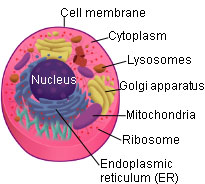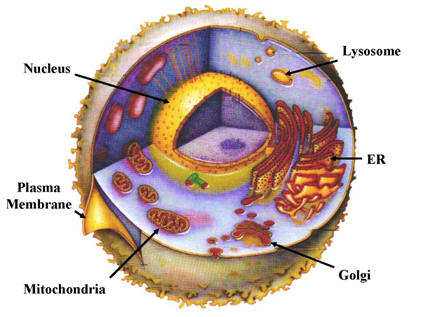Each organelle has a specific role to play in the cell, and has a distinctive shape and size. One organelle is the command center; others provide the cell with energy, while still others manufacture proteins and additional molecules that the cell needs to survive and to communicate with the world around it. The entire cell is enclosed in its membrane that not only keeps the cell intact, it also provides channels that open and close to allow selected molecules into and out of the cell.

Nucleus - The nucleus generally contains the genetic material for the cell. Because it contains the DNA (unrolled 1.8 metres long)and chromosomes, which affect the proteins that determine the activities of the cell, the nucleus can be considered to be the cell's control (command) center.
Ribosomes - Ribosomes are where protein synthesis takes place. Some are attached to the rough endoplasmic reticulum (ER), and some are free in the cytoplasm.
Endoplasmic Reticulum (ER) - The ER is a series of interconnecting flattened tubular tunnels. There are two sorts of endoplasmic reticulum - rough ER and smooth ER. The rough ER has lots of attached ribosomes. The smooth ER has no attached ribosomes (looks 'smooth'). The rough ER takes in the proteins made on the ribosomes so that they cannot escape into the cytoplasm. The smooth ER is not involved in protein synthesis, but has other functions. For details on the ER, click here.
Golgi apparatus -The Golgi apparatus (complex) is composed of small membranous sacs, and is associated with the ER. Though its function is still not entirely understood, it seems that proteins from the ER travel to the Golgi apparatus, where they are transformed and packaged into sacs before being moved to their final destination. For details on the Golgi complex, click here.
Lysosomes - Lysosomes are membrane-bound sacs of enzymes. In a controlled and specific way, they break down old or unneeded parts of the cell into small organic molecules that can be reused.
Mitochondria - Mitochondria are large organelles where oxygen is combined with food to produce ATP (adenosine triphosphate), the primary energy source for the cell. Mitochondria contain their own DNA, RNA and ribosomes, and can reproduce themselves independently of the cell in which they are found.
